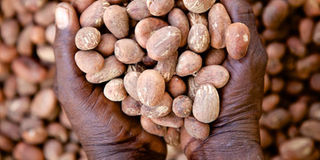Shea butter: Uganda’s hidden treasure

Raw shea butter seeds. Uganda is yet to reap from sheer butter unlike other African countries like Ghana where it is a major export.
What you need to know:
- A shea tree needs an average of seven to eight years to produce the first harvest. However, those that have faced a lot of bush fires may become stunted and take up to 15 years to bear fruit. During harvest, a tree can yield up to 20kgs of fresh fruit which produces about 5kgs of dry kernel that are made up of 42 to 48 per cent oil. The fruits resemble plums and take about four to six months to fully ripen.
Shea butter or Moo yao as it is known in Lango and Acholi sub-regions is an indigenous fruit tree that grows mostly in northern Uganda. Its fat containing kernels are sold both on the local and international markets.
In terms of importance in Africa, its oil is second to palm oil.
Although it has great contributions to local economies, shea butter has not been exploited in the country. This is because the tradition of planting trees is lacking: most of them occur naturally, especially in parklands.
Growth
A shea tree needs an average of seven to eight years to produce the first harvest. However, those that have faced a lot of bush fires may become stunted and take up to 15 years to bear fruit. During harvest, a tree can yield up to 20kgs of fresh fruit which produces about 5kgs of dry kernel that are made up of 42 to 48 per cent oil. The fruits resemble plums and take about four to six months to fully ripen.
How to plant
Clear an area of well drained soils preferably sandy or clay.
It is best that seeds be sown towards the end of the rainy season so as to ensure proper drainage.
The seeds should be half buried with the eyes facing upward.
The spacing between the seeds placed in the soil should be between two to three metres.
Apply organic fertiliser to the soil. Organic fertilisers should be used because inorganic fertilisers destroy soil quality.
Water in early stages helps ease absorption of nutrients from the soil by the seeds and to protect the soil from other dry conditions.
Remove weeds around the seedlings regularly to avoid competitions.
Smoke the trees frequently to protect them from pests.
Harvests
The seeds fall by themselves to the ground and are collected in baskets and taken for processing.
De-pulping is done to get rid of the sweet fleshy fruit by boiling the fruit. They are then left to ferment. The fermented fruits are then sun-dried for about 10 days at temperatures below 50°C.
The seeds are then de-husked by trampling or pounding to remove the hard brown cover to extract the kernel.
The kernel is then baked or roasted over controlled heat to prevent it from burning. Extracting butter from the baked kernel involves grinding the nuts into fine powder which is then mixed with warm water.
The semi-solid mixture is then kneaded to form a paste.
The paste is left and with time, oil begins to collect at the top. The oil is collected periodically until it is all exhausted.
The writer is media and communications officer, FIT Uganda
Uses of shea butter
It is used as a moisturizer as it is rich in vitamin A, E and F which soothes, balances and hydrates the skin.
Shea butter speeds up healing of wounds.
It promotes growth of healthy tissues in ulcerous wounds
It is used to treat baby circumcision wounds
For frying and making of stew
The residue left after oil extraction is used to decorate traditional mud houses and also to harden the walls and make them stronger.
Although shea butter is on high demand in the international market, its production remains at a largely subsistence level in Uganda mainly earning domestic income for the rural northern woman as compared to Ghana and Senegal who export it, contributing greatly to their economies. It is therefore, important for the government and farmers equally to engage in the production of shea butter at a commercial level as this can greatly contribute to the growth of the country’s economy.




